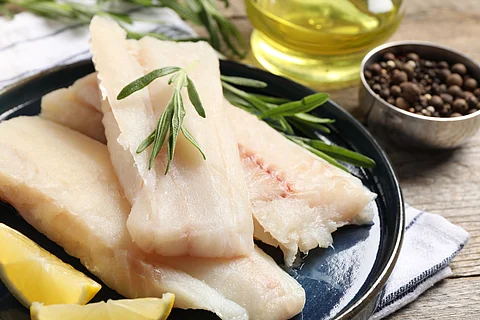

Cod consumption has dropped, while cheaper saithe has gained in popularity, according to the Norwegian Seafood Council.
Photo: Adobe Stock
Almost half of consumers say price is a barrier to eating seafood regularly, according to new research published by the Norwegian Seafood Council (NSC). The organisation claims that inflation and higher food prices are driving a shift away from cod towards alternative whitefish species such as saithe, a species in the cod family which is currently the most-caught fish in Norwegian waters.
The Council cites data from market research firm Kantar indicating that cod consumption in UK households has dropped by as much as 18% in recent years. At the same time, figures from Consumption Research Norway (SIFO) suggest that food costs have risen at twice the rate of other goods over the past three years, putting pressure on household budgets.
The NSC argues that this changing behaviour is creating opportunities for whitefish species with lower prices and strong availability. It highlights saithe as one such option, describing it as versatile for cooking and a good choice for everyday meals.
Nutrition and sustainability key factors alongside price
Nutritional comparisons also play a role, the NSC says, citing analysis from matvaretabellen.no which shows saithe contains slightly more protein than cod or Alaska pollock, alongside comparable calorie and fat content. NSC says suggest this could appeal to younger consumers, noting that McKinsey research finding Generation Z buyers are more likely to prioritise protein-rich, healthy and fresh products, according to the NSC.
Sustainability is another factor, according to the council. Saithe, a relative of the cod, is reported to be the most-caught whitefish in Norwegian waters, with healthy stocks in the Barents Sea and quotas described as generous. The NSC cites surveys indicating that 46% of consumers are buying more sustainable products, and almost 85% say they have directly experienced the effects of climate change.
“Research-based knowledge and advice are crucial for sustainable seafood management. Through this approach, the Norwegian seafood industry must always ensure sustainable practices," Bjørn-Erik Stabell, head of strategy and sustainability at the NSC, said via a press release. "Choosing saithe from healthy fish stocks is therefore a good way of exploring new and under-utilized species.”
Saithe an "under-utilized fish" with potential, says NSC
Norwegian authorities manage fisheries under what is known as the “Norwegian model”, which bases quotas on advice from the Institute of Marine Research and includes strict reporting rules. The NSC says that catches of saithe have historically fallen below quotas, leaving stocks at a strong level and offering reassurance to consumers concerned about environmental impact.
“Shifts in consumer preferences, whether due to economy, available products or personal values, are shaping consumers’ food choices," said Lars Moksness, NSC Global Consumer Behaviour Analyst, commenting on the report findings. "With changing habits, we see a clear opportunity to explore new products utilising these lesser-used species.”
“Saithe, as an example, has been an under-utilized fish in many parts of the world. At the same time, it is well loved for both taste and versatility. As available fish stock and regulations might hinder the catch of some species, alternatives like saithe could ensure that consumers still get high- quality, nourishing seafood in the coming years.”
The findings form part of the council’s latest consumer trends report, Navigating the World of Megatrends, which explores how global changes may influence seafood consumption over the coming decades.
